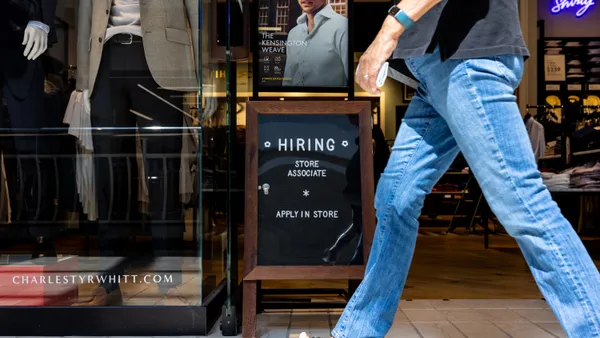Dive Brief:
- The U.S. unemployment rate inched slightly upward in October to 3.6%, just one-tenth of a percentage point higher than the 50-year low reported last month, according to the U.S. Bureau of Labor Statistics (BLS).
- The "food services and drinking places" sector led all job categories in growth during October, with 48,000 positions added. Employment in the sector is on an upward trend going into the holiday season, averaging 38,000 jobs per month over the past three months, per BLS.
- Two other sectors — healthcare and professional and business services — saw continued growth after leading September's jobs numbers. The manufacturing sector lost 36,000 positions last month, marking the first time in 2019 that the sector posted two consecutive months of job losses.
Dive Insight:
The job market has held steady in the final months of 2019, indicating more of the same for U.S. employers looking to hire. The better-than-expected October total of 128,000 additional jobs means plenty of opportunities for job seekers, Irina Novoselsky, CEO of CareerBuilder, told HR Dive in an emailed statement.
"With so many opportunities for job seekers, employers will continue to face problems such as job hopping," Novoselsky said. "While job seekers remain in control, employers must keep their competitive edge and leverage new tools instead of relying on traditional, outdated methods."
October's unemployment rate came in one-tenth of a point lower year-over-year. But an analysis of the data from these two reports shows even more subtle differences. In October 2018, the economy saw a boost from the manufacturing and construction sectors, complementing the healthcare sector which added the most jobs that month.

The BLS report indicated manufacturing's losses may be at least partly attributable to the automotive sector. Job losses in the motor vehicles and parts segment reflected strike activity, BLS said. October marked the end of the General Motors strike after which the company agreed to some pay raises and factory investments, along with other concessions, Vox reported.
Talent scarcity is forcing larger companies, including Walmart and Microsoft, to get creative in recruitment. Strategies on display at a U.S. Chamber of Commerce showcase last month included apprenticeship networks, investments in local schools and job training programs for low-income and formerly incarcerated individuals, among others.












